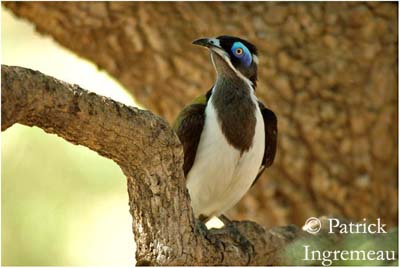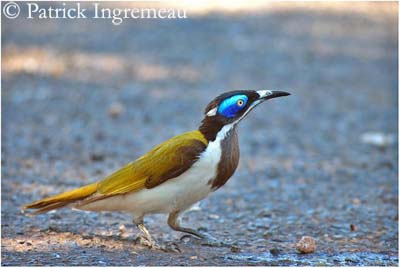
Blue-faced Honeyeater
Entomyzon cyanotis
Passeriforme Order – Meliphagidae Family
BIOMETRICS:
Length : 25-32 cm
Weight : 105g
DESCRIPTION:
Blue-faced Honeyeater is also known as Bananabird. This bird is a pest for Banana-plantations where it strongly damages ripe fruits.
PROTECTION / THREATS / STATUS:
Blue-faced Honeyeater is common and widespread in its range. It is considered as pest for orchards.
Fr: Méliphage à oreillons bleus
All : Blauohr
Esp : Pájaro Miel de Cara Azul
Ital : Mangiamiele faccia azzurra
Nd : Blauwwang-honingeter
Russe : Голуболицый медосос
Photographs by Patrick Ingremeau
His website : TAMANDUA
Text by Nicole Bouglouan
Sources:
HANDBOOK OF THE BIRDS OF THE WORLD Vol 13 by Josep del Hoyo-Andrew Elliot-Jordi Sargatal - Lynx Edicions – ISBN: 9788496553453
Birds in backyards (Birds Australia and Australian Museum)

Adult male has olive-green upperparts, wings and tail. Flight feathers are dark brown.
Underparts present black chin and breast, forming pointed black bib. Rest of underparts is white.
On the head, forehead, crown and nape are black. Narrow white stripe crosses the nape, and other white stripe starts from lower base of the bill, as moustachial stripe, and joins the underparts through the breast sides. We can see conspicuous bare cobalt-blue skin around the eyes.
Bill is strong, conical, pale blue with dark grey tip. Eyes are pale yellow. Legs and feet are blue-grey.
Both sexes are similar.
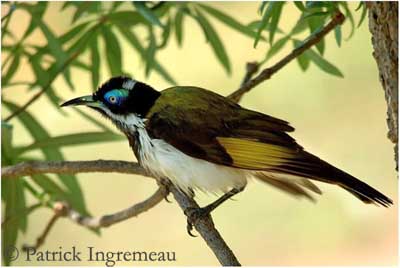
Juvenile resembles adults, but it has bare olive-green facial skin and base of the bill. Head is brownish and chin is pale grey.
We find three main subspecies:
E.c. albipennis has white patches on wings, visible in flight. It lives in north-west of Australia.
E.c. cyanotis has smaller buffy-white patches, and lives further in the east of the continent.
E.c. griseigularis, lives in south-western of New Guinea.
VOICE: SOUNDS BY XENO-CANTO
Blue-faced Honeyeater is very noisy. It utters repeated “woik”. At dawn, we can hear “weet-weet-weet-weet”, and it can call during 30 minutes in the early morning. When in flight, it gives squeaks and soft “hwit-hwit”.
HABITAT:
Blue-faced Honeyeater lives in open woodlands with Eucalyptus, mangroves, orchards, parks, golf courses and gardens. It is found in wet habitats or semi-arid areas, and in trees along water courses.
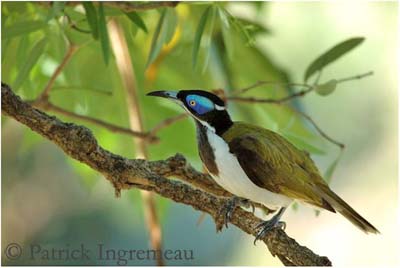
RANGE:
Blue-faced Honeyeater is found in northern and eastern parts of Australia, and also in Papua New Guinea.
BEHAVIOUR:
Blue-faced Honeyeater is very curious and aggressive. It is a pest for orchards and it damages banana-plantations, by eating ripe fruits. It moves in small groups for feeding. They forage for fruits, nectar and insects high in trees. They are noisy and gregarious.
They sometimes feed in mixed groups, but they also tend to exclude other birds from the area.
Blue-faced Honeyeater is rather sedentary in northern parts of its range, and may be locally nomadic in the south. This species performs seasonal movements, according to food resources.
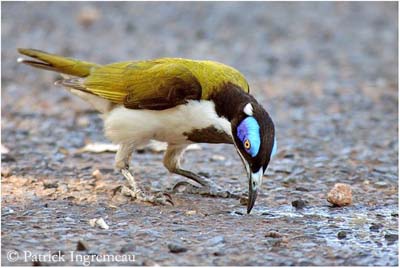
Blue-faced Honeyeaters form breeding pairs or are cooperative breeders. Immatures help the dominant pair, sharing the nesting duties such as incubation and feeding of nestlings.
FLIGHT:
Blue-faced Honeyeater has fairly active flight, but rarely over long distances.
REPRODUCTION:
Breeding season occurs from June to January.
Blue-faced Honeyeater often uses and abandoned nest of other bird species. It may modify the nest or not, but it often adds nest materials and new lining.
If it builds a new nest, it makes a rounded cup with bark, and lined with softer materials such as finer bark and grass.
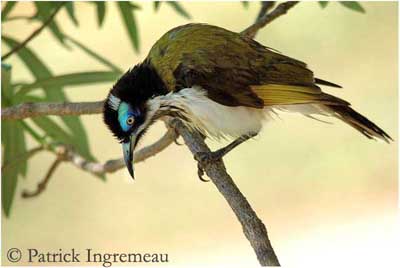
Female usually lays two eggs. Incubation lasts about 16 days, by both parents and sometimes helpers.
Young are fed by adults and other members of the group. Young remain some time with parents after fledging.
This species can produce one or two broods per season. Nests may be parasitized by Cuckoos.
DIET:
Blue-faced Honeyeater feeds mainly on fruits, insects and nectar from flowers, native or exotic plants.
It forages in small groups on tree branches or in foliage.
